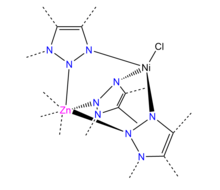Mircea Dincă
Mircea Dincă (born 1980) is a Romanian-American inorganic chemist. He is an associate professor of chemistry at the Massachusetts Institute of Technology. At MIT, Dincă is leading a research group who focuses on the synthesis of "functional metal-organic frameworks (MOFs), which possess conductive, catalytic, and other material-favorable properties.

Early life and education
Mircea Dincă was born in Făgăraş, Romania. His passion for chemistry began in his chemistry class in 7th grade, where he had a “dedicated teacher that did spectacular demonstrations with relatively limited regard for safety”. In 1998, he represented Romania at the International Contest in Yakutsk, Russia, where he won first prize.[1]

After high school, Dincă was offered a scholarship from Princeton University and moved to New Jersey in 1999. At Princeton, he worked with Jeffrey Schwartz, conducting research on materials science. After graduating Magna Cum Laude in 2003, Dincă went on to the University of California at Berkeley to attend the Chemistry doctorate program, where he worked with chemistry professor Jeffrey Long on increasing H2 applications with mobile hydrogen storage applications. He graduated with his Ph.D. from Berkeley in 2008.[2]
Career
Dincă completed his postdoc studies at M.I.T., where he was promoted to associate professor in 2010 and, in 2017, tenure.[2]
Research
Dincă’s research primarily focuses on electrical conductivity of MOF's, which was previously unknown and resulted in a new categorization of such materials with “charge mobility values”.[3] His focus is on the exploration of increasing electrical conductivity capacities through the marriage of organic and inorganic materials to assemble hybrid MOF's.
Research includes exploring electrochemical cycling through strongly adhering, electroactive metal–organic framework thin films to vary results, such as multicolored electrochromic responses[4] and transparent to dark behavior.[5]
Awards and honors
Dincă has received the following awards:[2]
- June 7, 2011 -- DOE Young Investigator Award
- March 29, 2013 -- 3M Non-Tenured Faculty Award
- February 18, 2014 -- Cottrell Scholar Award and the Sloan Research Fellowship
- November 24, 2015 -- Dream Chemistry Award
- April 14, 2016 -- 40th winner of the Alan T. Waterman Award
- May 05, 2016 -- Camille Dreyfus Teacher-Scholars
- August 21, 2017 -- ACS Award in Pure Chemistry
References
- "Dinca Research Lab - About Mircea Dinca". web.mit.edu. Retrieved 2018-11-29.
- "MIT Department of Chemistry - Dincă Research Lab". web.mit.edu. Retrieved 2018-11-29.
- "Materials research earns chemistry professor 40th annual Alan T. Waterman Award | NSF - National Science Foundation". nsf.gov. Retrieved 2018-11-29.
- Wade, Casey R.; Li, Minyuan; Dincă, Mircea (2013-10-16). "Facile Deposition of Multicolored Electrochromic Metal-Organic Framework Thin Films". Angewandte Chemie International Edition. 52 (50): 13377–13381. doi:10.1002/anie.201306162. ISSN 1433-7851. PMID 24133021.
- Alkaabi, Khalid; Wade, Casey R.; Dincă, Mircea (2016-08-11). "Transparent-to-Dark Electrochromic Behavior in Naphthalene-Diimide-Based Mesoporous MOF-74 Analogs". Chem. 1 (2): 264–272. doi:10.1016/j.chempr.2016.06.013. hdl:1721.1/107566. ISSN 2451-9294.